Hawaiian South Shore May 2020 Newsletter
Share
NEWSLETTER MAY 2020

Surviving the Surf Shutdown
How the Surf World Dealt With
the COVID-19 Quarantine
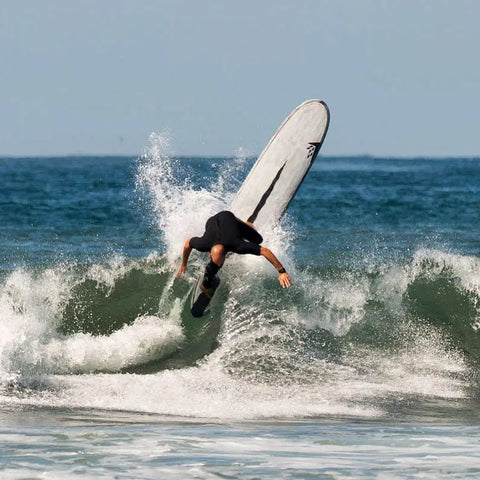
It has been a rough couple of months for the world, with COVID-19 infecting millions and effectively shutting down the economy. And
although our troubles might pale in comparison to those who have lost family members and friends to this pandemic, it’s been a pretty
rough couple of months for the world’s surfers. Here in Hawaii we were allowed to surf through
the quarantine, but in most areas of the world lineups have been empty, due to government bans on surfing. As you can imagine, people have been going a little stir crazy.
Professional surfing took a bit of a hit as well. A lot of major brands had to close doors during the shutdown, and a lot of sponsored athletes saw their contracts get cut in half, if not voided altogether. Meanwhile, the WSL cancelled the first three world tour events of the year, and all of the QS, longboard, and junior events in April and May. Whether the competitive year is able to start in June or ends of being cancelled completely still remains to be seen.
But it wasn’t all bad in the surf world. The WSL started a number of #challenges, such as the #homebreakchallenge that saw people around the world finding creative ways to keep their stoke alive while at home. People have been submitting videos of themselves surfing in hammocks, on Swedish exercise balls, in ropedrawn wagons, on skateboards, in tarp barrels, and even in live stop-motion films. The WSL will be awarding a Home Break Challenge Champion, so tune in to #homebreakchallenge and worldsurfleague.com to check it out, or to
submit videos of your own!
A number of musically inclined members of the surf industry also participated in a cover song challenge, singing and playing songs, then challenging their friends to do the same. WSL commentator Joe Turpel, professional surfer Conner Coffin, and even the GOAT, Kelly Slater himself, posted videos of themselves shredding on guitars and ukuleles. As it turns out, there are a lot of pro surfers with musical talent. Other noteworthy Musicians include Steph Gilmore, Tom Curren, Landon MacNamara, and Makua Rothman.
Other popular challenges on Instagram include the hack challenge (where people posted their best clips of turns), the tube challenge (best clips of barrels), a “knifing it” challenge (clips of heaviest drops), and of course a wipeout challenge. A lot of our surfing brothers and sisters might not have been in the water much over the past two months, but they were definitely shredding on social media!
Europe had some of the strictest lockdowns and bans on surfing, but Spanish favorites like Kepa Acero kept the vibes high, regularly posting from home, keeping people updated, and trying his best to encourage people and raise the stoke and froth level. In a hard time such as this one, it is good to see so
much positivity and camaraderie within our community. We may have been challenged by COVID-19, but we will all make it through this pandemic together.
Three Great Ways to Keep Your Stoke and Train for Surfing at Home
As you probably know, a lot of people around the world spent the past month on lockdown at home, and not all of them were as fortunate as we were here in Hawaii. While we were able to surf as part of our exercise here in the islands, many other surfers were landlocked for weeks and even months. They had to find
creative ways to stay stoked and in shape for surfing—something that many of us have had to do at some point in our lives, whether due to a lack of swell, living somewhere far from the ocean, or other external factors beyond our control. Fortunately, there are a number of fun ways to “surf” while at home. Here are
three of them:
1) Slackline: Slacklining is often thought of as a pastime for stoners in parks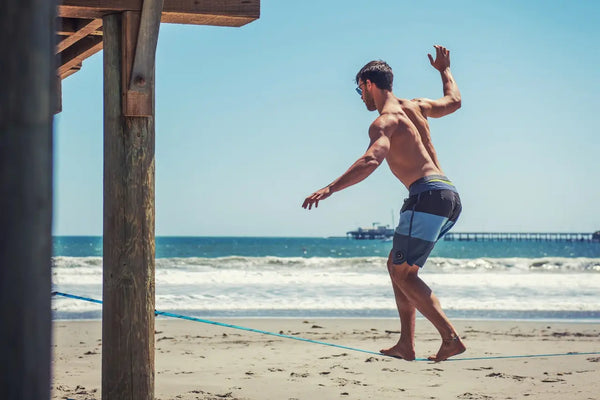 and rock climbers in sweaty gyms, but it’s actually a great activity to keep you fresh for surfing as well. Not only does it help you work on your balance (and even your cross-stepping!), it also builds core and leg strength, which are essential to good surfing.
and rock climbers in sweaty gyms, but it’s actually a great activity to keep you fresh for surfing as well. Not only does it help you work on your balance (and even your cross-stepping!), it also builds core and leg strength, which are essential to good surfing.
2) Balance boards: While the Indo Board was the first, there are now a number of different balance boards on the market, all of which provide pretty similar benefits, including exercise, balance, and fun. If you can’t actually get in the water to surf, you can always set your balance board up in front of the TV and watch your favorite surf film while pretending to surf in the comfort of your living room.
 3) Skateboard: Skating was invented by surfers during the long summer months when the surf was dismal and uninspiring. These days, it has become a sport of its own, with many different styles and subcultures to choose from. You can cross-step a longboard, practice airs in the halfpipe, bomb hills, work on your street skills, or practice your carves on the driveway. No matter how you end up riding a skateboard, it will probably make you a better surfer.
3) Skateboard: Skating was invented by surfers during the long summer months when the surf was dismal and uninspiring. These days, it has become a sport of its own, with many different styles and subcultures to choose from. You can cross-step a longboard, practice airs in the halfpipe, bomb hills, work on your street skills, or practice your carves on the driveway. No matter how you end up riding a skateboard, it will probably make you a better surfer.
May Member of the Month
Q & A with Chris Sumiye
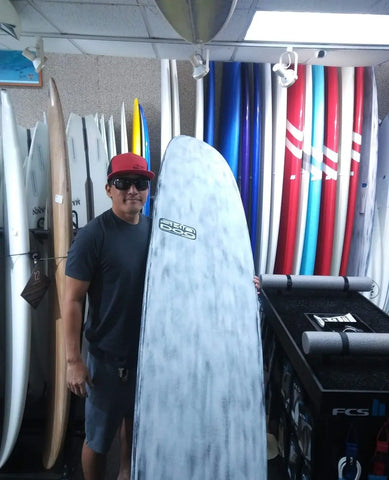
When and why did you initially get into surfing?
I got into surfing back in the late 80’s when my dad brought home a Glen Minami twin fin surfboard for me. I was totally shocked and obviously was super excited to try it out. I remember the first session out at Makaha beach...I was hooked and I still have that board. A bunch of my friends also started to surf as well at that time so that started the whole surfing adventure for me.
Did you have a time period you laid off
from surfing? If so, when and why did you
start back up?
I stopped surfing in my late 20’s/early 30’s for various reasons then about 15 years later I started back up again. I short boarded during my younger years and when I decided to try surfing again I went down the longboard path. It was like learning all over again, things like foot placement, balance, etc., but I immediately felt that connection with the ocean again. The reason why I started back was for health reasons. During my 15 year hiatus I gained some weight and developed
poor health habits and my doctor said I needed to do something about it fast because my blood pressure was way too high. So the day after that doctor’s appointment I bought my first longboard and went surfing to try and get healthier. It’s been about 5 years now and I can truly say surfing helped get my life and body back into shape. I am healthier and happier because of surfing.
What is your favorite thing about surfing?
There are many things I enjoy about surfing but I guess my favorite thing are the bonds I make with fellow surfers out in the water. It is amazing that after 15 years of not surfing, when I see old-timers in the water from when I surfed in high school/college, we still recognize each other and can share stories
about the old days. I also got to re-connect with some of my high school buddies because of surfing and have also developed many new friendships, and the new memories being created are priceless. On another note, nothing beats the feeling after you had an awesome session (that one turn, barrel, or maneuver).
Where is your favorite place to eat after surfing?
Back in the day our favorite place to grind after surfing was either Diner’s on Piikoi, an ice house at the end of the docks (bowls area) or Waimalu Zippy’s. Nowadays we go home to the family after surfing. What is your favorite item on the menu? Diner’s was the cheeseburger special or loco moco, the ice house was the tuna sandwich, and Zippy’s was the chili burrito.
What other hobbies do you have besides surfing?
Besides surfing, I enjoy other ocean-related activities such as diving and fishing. If I’m not doing one of those things than I am with my wife doing something she enjoys.
What type of work do you do?
I started off as a school counselor at Waianae High School and currently am a school Registrar for a Hawaii State Public Charter School.
Tell us about the board you recently purchased from us. What model and size is it, and how do you like its performance?
A little over a year ago I purchased a Skindog Smoothie Xeon (9’1”x22.25”x2.75”). The board was what I was looking for in a longboard...something that could turn similar to a shortboard but paddle like a longboard. Previous boards, I used always had one element missing, either it was a little too heavy, too stiff, hard to turn, or slow. I did not mind any of that because I was starting back into surfing however as the years progressed so did my desire to improve. The Smoothie had everything I was looking for...it was lighter, faster, more maneuverable, and a lot stronger than my usual poly longboards (not to mention the board is beautiful aesthetically). It really performs well in surf from 1 to a solid 3/4 foot and I’ve been surfing it every day I go out for the last 15 months. I don’t go out when it gets bigger than 3-4 feet so I can’t say how it performs in bigger surf. I actually purchased a Carbon version about 4 months ago and it performs just like the Xeon but with a little more projection in solid surf. Awesome boards!!!
Do you have any additional comments?
I would like to thank everyone at Hawaiian South Shore (David and Brett) for going above and beyond to help perpetuate a positive surfing lifestyle and attitude, both in and out of the water. You guys/gals are the best!!!
Aloha!
Dave’s TCM Treatment
It also includes the emotional, energetic, and spiritual aspects of the individual. It doesn’t mean the health practitioner will address all these aspects but will take them into consideration for each individual.
 Dave has been open about his health journeys in these newsletters, so he asked me to share some of my perspectives on his health. I will present the more significant symptoms for ease of clarity.
Dave has been open about his health journeys in these newsletters, so he asked me to share some of my perspectives on his health. I will present the more significant symptoms for ease of clarity.
• Feels colder compared to other people and
feet tend to be cold as well as other parts
of his body
• Light sleeper with 2-3 times of waking up at
night
• Low energy
• Takes immunosuppressants for kidney
transplant since 1999
• Night sweats
• Loose stools but not presently
• Low back pain & tightness
• Pulse: Kidney position – weak
• Tongue body: pale and swollen with
scalloped edges
• Tongue coat: thick and white
Putting all these signs and symptoms together gives me a picture of Dave’s condition. Starting in 1999 after his kidney transplant and taking the immunosuppressants, many symptoms started occurring. The Kidney energy (qi/ki) (氣/気) may have been deficient already before the transplant and continued in spite of the new kidneys because of the immunosuppressants he had to take to prevent his body from rejecting them. In TCM theory, the Kidney energetic function includes storing a substance called the jing ( 精) or essence which can transform into ‘qi’ and blood. It is also the source of primordial/prenatal yin and yang, hence the Kidney is an essential organ for the production of
fundamental substances to support the other organ energetic functions required for health. The Kidney is also responsible for the health of the immune system which the immunosuppressants are suppressing. In Dave’s situation, his Kidney yang is deficient leading to the Kidney being unable to warm the body. A deficiency in kidney yang can result in cold and soreness in the knee and back regions, aversion to cold, incontinence, ED, infertility, edema, and diarrhea in the early hours of mornings.
One of the organs affected by the Kidney yang deficiency is the Spleen. According to TCM theory, the Spleen is in charge of digestion. Think of the Spleen as the stove of the body that breaks down the food in the stomach
and separates the food qi and the materials that form the stools the body removes. The Kidney Yang is the fire under the stove to cook the food. Most elderly Chinese will not drink ice cold drinks or eat too many cold or cold energetic foods in fear that the fire will be put out. Dave’s previous loose stools could be because of a Spleen yang deficiency due to Kidney yang deficiency. The Spleen is also in charge of producing ‘Blood’, both the visible red substance and its energetic aspect. With Dave’s Spleen deficiency, there is a Blood deficiency that may or may not show up as anemia. Another Spleen energetic function is the regulation of fluids and a Spleen yang deficiency can create ‘dampness’ or swell in the body. Thus, the swollen pale tongue with a thick white coat can be attributed to the yang and Blood deficiency. Yang and Blood deficiency also leads to being easily tired or fatigue.
With TCM theory, in a Blood deficiency condition, the Heart cannot be properly
nourished. The Heart houses the Spirit and with the house uncomfortable, the Spirit will be restless. This will affect the quality of sleep. See Dave’s article, “The Value of Naps”, for the benefits of sleep. Also, with Blood deficiency, night sweats can occur.
The TCM diagnosis would be ‘Kidney and Spleen yang deficiency’ and ‘Blood deficiency’. In TCM, there are different ways to treat these conditions. Some of these modalities are acupuncture, tuina (Chinese medical massage), herbs, medicinal foods, moxibustion/heat, and exercise including qigong, yoga, tai chi, etc. Dave’s treatment included acupuncture, tuina with Chinese herbal liniment, stretching as well as teaching some stretches (Dave does yoga already!),
and giving him a list of foods to nourish his yang and Blood. The acupuncture points used on his back were points that affected his Spleen and Kidneys, as well as points used with electricity to loosen and relax the low back muscles. Points on the front side of the body included point formulas to regulate the qi in the body, tonify the Kidney and Spleen, nourish the blood, strengthen the immune
system, calm the Spirit and raise the yang. This modality worked on the energetic aspect of the body, while the tuina with liniment and stretching worked on the physical aspect.
Another modality used was ‘vibroacoustic’ therapy with the use of music played at
a frequency that can be felt through the treatment table. This I call ‘3D music’ where you hear the music, feel the music’s vibration, and the music is set at a frequency that entrains the brain to a lower frequency. The lower frequency is set to that of a person who is meditating. For most people, the autonomic nervous system is affected.
The autonomic nervous system consists of two parts: sympathetic and parasympathetic systems. Just to simplify things, the sympathetic nervous system is related to the ‘fight or flight’ response where adrenaline and cortisol are released. With chronic stress, there’s long-term stimulation of the sympathetic nervous system which can lead to depressing the immune system and is associated with metabolic diseases, such as diabetes, hypertension, and cardiovascular disease. The parasympathetic nervous system is the opposite in that it is related to ‘rest and digest’ and it’s easier to relax, digest foods, dilate blood vessels to lower hypertension, and increase the immune system. There are many ways to ‘turn off’ the sympathetic nervous system and ‘turn on’ the parasympathetic nervous system, including yoga, tai chi, qigong (Chinese
energetic exercises), biofeedback, hypnosis, meditation, etc.
A few days after Dave’s treatment, he showed me a link to another TCM practitioner showing an exercise to increase Kidney yang qi. I was impressed with Dave’s initiative to find ways to tonify his deficiencies. I was familiar with the exercise and have taught a variation of it. I shared that with Dave. With my treatment and his food therapy and exercises, we’ll see how his body responds.
Yoga Poses That Will
Help you Surf Better
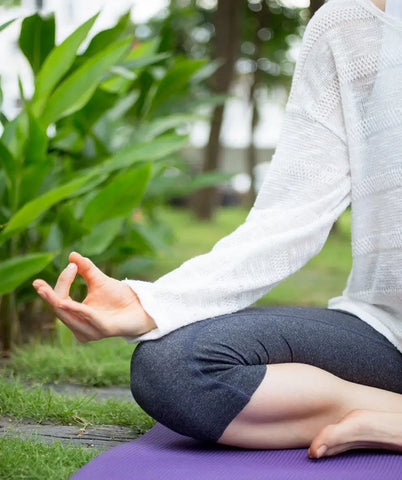
During challenging times, sometimes the best thing to do is to look for the silver lining. The months of March and April were hard for a lot of people, due to illness, lost jobs, financial difficulties, and the global pandemic/economic shutdown as a whole. To make matters worse, in many places around the world, surfers were restricted from paddling out and enjoying the natural healing that the ocean provides to our bodies, minds, and souls. But during times like this, when our
daily routines are upset and we are unable to do the things we love to do the most, we have an opportunity to branch out and broaden our lives by learning and embracing new, healthy practices. Over the past couple of months,more surfers than ever turned to yoga as a physical practice that they could do while
sheltering at home—and that kept them fit and flexible for when the surf was once again accessible.
Hawaiian South Shore’s favorite yoga teacher Kilty Inafuku (www.kiltyyoga.com) has been leading donation-based online classes throughout the COVID-19 crisis, helping people stay grounded and healthy during this difficult time. Today, she talks to us about why yoga is so important for surfers and teaches us five yoga poses we should all be doing before and after we paddle out.
Why Yoga Is Important for Surfers
Yoga is not just a physical activity itself, but also an important complement to the other types of exercise that we do. Overstretching muscles and requiring them to perform a range of motion where they cannot recruit power can cause injuries, so it is important to prepare for activity by performing postures that both make muscles stronger and improve range of motion.
Other factors that can cause injury include repetitive motion and overuse and these are both problems that are very common in surfers. To mitigate these issues, it is important to perform poses that counteract this overuse—stretching what has been flexed and strengthening muscles that are neglected during your repetitive motion. Yoga is a great way to do all of this, keeping you stronger, more flexible, and healthier in both the short and long run.
Different Poses for Different Muscles
Before a surf session, it is a good idea to stretch your body and warm it up for the movements you will soon be doing. You want to prepare your body for actions such as paddling and riding waves. And the same holds true after a session when your body is recovering. The muscles you use while surfing will likely be
pretty tight, so you will want to stretch them out to help them recover.
Paddling Muscles
Paddling uses muscles such as biceps, triceps, deltoids, latissimus dorsi, obliques, and rectus abdominus. Make sure you integrate stretches for the chest, side body, and anterior shoulders. Yoga poses that help with this include:
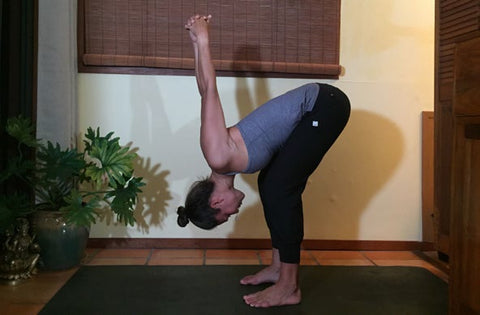
Uttanasana (forward fold), with arm variation of fingers interlaced behind back: From a standing position, hinge at the hips into a forward fold. If your low back is extra tight, it may help to maintain a bend in the knees. Then interlace your fingers behind your back and reach your fists away from your back and
overhead.
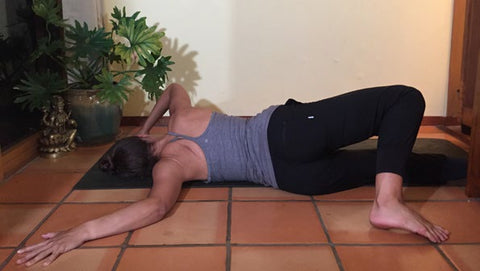
Prone chest opener: Lay prone on your stomach with your legs extended long. Reach your left arm out to the side, and rest it on the ground roughly at a 10 o’clock position. Place your right hand next to your right shoulder, with the palm on the ground. Pressing the palm into the ground will help with the next step.
Bend your right knee and slowly roll toward your left hip, until your right foot touches the ground behind you. Only go as far as you can comfortably feel a stretch across the front of your left shoulder. Once you hit that point, stop and rest your left ear on the ground, or alternatively a pillow/towel/block. Gently press
your left palm into the ground. This action helps to cultivate strength while your muscles are in a greater range of motion. Allow five breaths. Be gentle when you ease-out, and repeat on the second side.
Lower Back Muscles
When we lie on our boards, we often arch our backs and raise our chests, which helps us paddle faster and maintain balance while paddling. Unfortunately, this also stresses the back and shoulder muscles, such as the paraspinal muscles and trapezius. Use these two poses to stretch the posterior shoulders and back:
When we lie on our boards, we often arch our backs and raise our chests, which helps us paddle faster and maintain balance while paddling. Unfortunately, this also stresses the back and shoulder muscles, such as the paraspinal muscles and trapezius. Use these two poses to stretch the posterior shoulders and back:
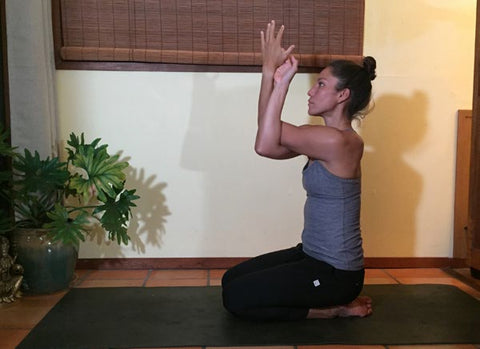
Garudasana (eagle) arms: Cross your right arm/elbow under your left, and pull the backs of your hands toward one another. If you have the range of motion, you can even hook your palms together. Lift your fingers up toward the sky and press your elbows forward to create a stretch in between your shoulder blades. Allow
five breaths, and repeat on the second side.
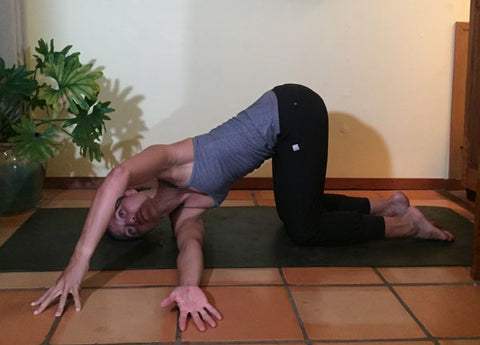
Thread the needle: Start in a tabletop position, on your hands and knees. Thread
your left arm behind the right wrist until your left ear and shoulder come to rest on the ground. Your left palm will be facing up toward the sky. This position yields a generous twist for the spine, especially if you press your right palm into the ground and encourage the twist. Simultaneously, press the back of your left arm down into the ground. This action helps to cultivate strength while your muscles are in a greater range of motion. Allow five breaths. Be gentle when you come out and back up to both hands, and repeat on the second side.
Core and Lower Body
Riding waves and pumping down the line requires a lot of effort from your core and lower body. The act of surfing often requires you to twist your upper body and put a lot of weight on the back leg, which can tighten up the glutes, abs, quads, and hip flexors. Stretch these muscles out by using this yoga pose:
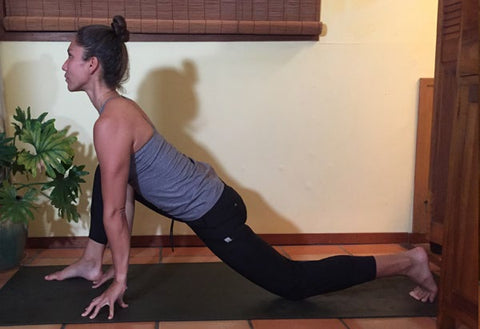
Lizard pose: From a standing position, fold forward and lunge your right foot back. Lower the back (right) knee down to the ground. Bring both hands to the inside of your front (left) foot. Stay up on your hands, or even fingertips. Allow a subtle tuck of the tailbone, and create the action of dragging the back knee toward the front foot. Although no part of your body will actually move from its position, the action will engage the quadriceps and hip flexors while they are in an elongated position. Allow five breaths. Repeat on the second side.
MORE TO READ...
➡️Hawaiian South Shore April 2020 Newsletter
➡️Yoga for Surfers: Prasarita Padottanasana (Wide - Legged Forward Bend)
➡️Who and What is Thunderbolt Technologies?
